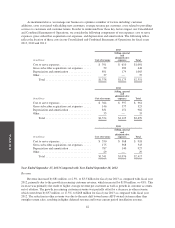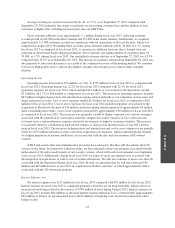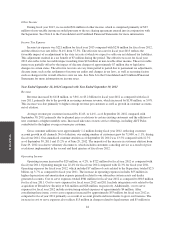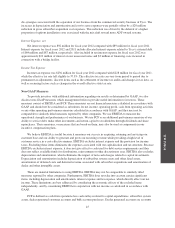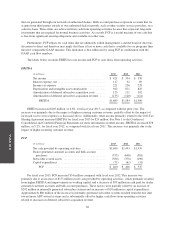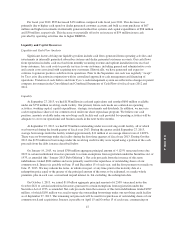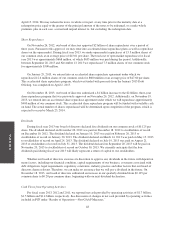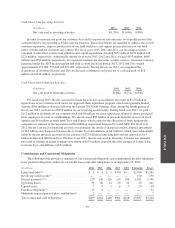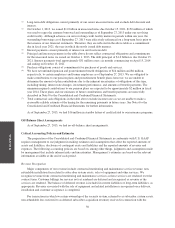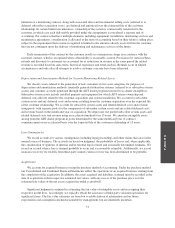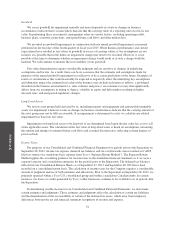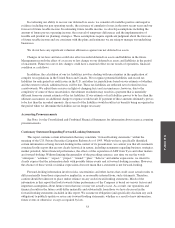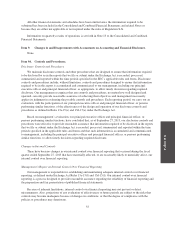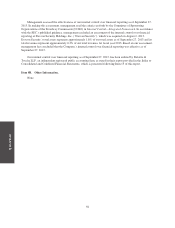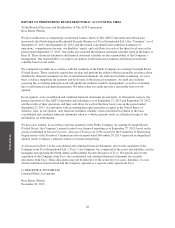ADT 2013 Annual Report Download - page 116
Download and view the complete annual report
Please find page 116 of the 2013 ADT annual report below. You can navigate through the pages in the report by either clicking on the pages listed below, or by using the keyword search tool below to find specific information within the annual report.
FORM 10-K
Goodwill
We assess goodwill for impairment annually and more frequently if events or changes in business
circumstances indicate that it is more likely than not that the carrying value of a reporting unit exceeds its fair
value. In performing these assessments, management relies on various factors, including operating results,
business plans, economic projections, anticipated future cash flows and other market data.
We recorded no goodwill impairments in conjunction with our annual goodwill impairment assessment
performed on the first day of the fourth quarter of fiscal year 2013. While historical performance and current
expectations have resulted in fair values of goodwill in excess of carrying values, if our assumptions are not
realized, it is possible that in the future an impairment charge may need to be recorded. However, it is not
possible at this time to determine whether an impairment charge would result or if such a charge would be
material. We will continue to monitor the recoverability of our goodwill.
Fair value determinations require considerable judgment and are sensitive to changes in underlying
assumptions and factors. As a result, there can be no assurance that the estimates and assumptions made for
purposes of the annual goodwill impairment test will prove to be accurate predictions of the future. Examples of
events or circumstances that could reasonably be expected to negatively affect the underlying key assumptions
and ultimately impact the estimated fair value of the business may include such items as follows: a prolonged
downturn in the business environment (i.e. sales volumes and prices); an economic recovery that significantly
differs from our assumptions in timing or degree; volatility in equity and debt markets resulting in higher
discount rates; and unexpected regulatory changes.
Long-Lived Assets
We review asset groups held and used by us, including property and equipment and amortizable intangible
assets, for impairment whenever events or changes in business circumstances indicate that the carrying amount of
the asset group may not be fully recoverable. If an impairment is determined to exist, we calculate any related
impairment loss based on fair value.
Impairments on long-lived assets to be disposed of are determined based upon the fair value less cost to sell
of the applicable assets. The calculation of the fair value of long-lived assets is based on assumptions concerning
the amount and timing of estimated future cash flows and assumed discount rates, reflecting varying degrees of
perceived risk.
Income Taxes
For purposes of our Consolidated and Combined Financial Statements for periods prior to the Separation on
September 28, 2012, income tax expense, deferred tax balances and tax carryforwards were recorded as if ADT
filed tax returns on a standalone basis separate from Tyco (“Separate Return Method”). The Separate Return
Method applies the accounting guidance for income taxes to the standalone financial statements as if we were a
separate taxpayer and a standalone enterprise for the periods prior to the Separation. The deferred tax balances
reflected in our Consolidated Balance Sheets as of September 27, 2013 and September 28, 2012 have been
recorded on a consolidated return basis. The calculation of income taxes for the Company requires a considerable
amount of judgment and use of both estimates and allocations. Prior to the Separation on September 28, 2012, we
primarily operated within a Tyco U.S. consolidated group and within a standalone Canadian entity. In certain
instances, tax losses or credits generated by Tyco’s other businesses continue to be available to us in periods after
the Separation.
In determining taxable income for our Consolidated and Combined Financial Statements, we must make
certain estimates and judgments. These estimates and judgments affect the calculation of certain tax liabilities
and the determination of the recoverability of certain of the deferred tax assets, which arise from temporary
differences between the tax and financial statement recognition of revenue and expense.
52


